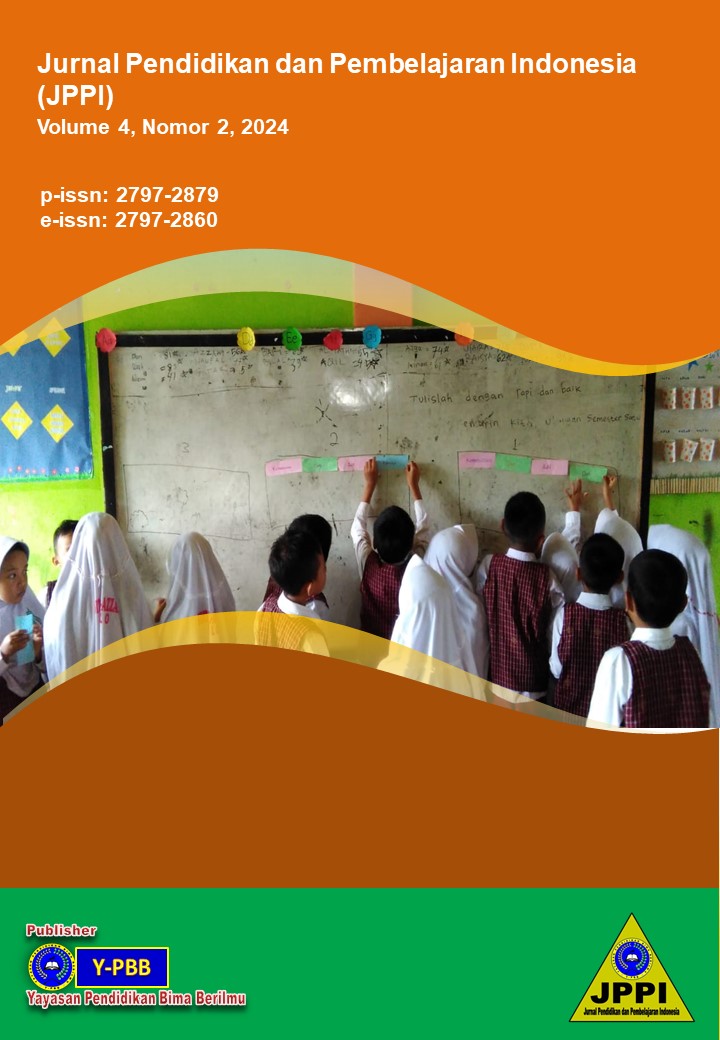English Language Learning Strategies Integrated with Technology to Improve the Learning Outcomes of Junior High School Students in Palu City
DOI:
https://doi.org/10.53299/jppi.v4i2.519Keywords:
English, Learning strategy, TechnologyAbstract
This study investigates how English language learning strategies integrated with technology impact the learning outcomes of junior high school students in Palu City. The research employs a mixed-methods approach, combining quantitative surveys, pre- and post-tests, qualitative interviews with teachers, and classroom observations. A total of 150 students from three schools participated, providing data on their perceptions of technology in learning English and their proficiency in reading, writing, speaking, and listening skills. Quantitative analysis revealed significant improvements in all tested skills following the implementation of technology-integrated strategies, supported by statistical findings (p < 0.05). Surveys indicated positive student attitudes towards technology, citing increased understanding, motivation, and enjoyment in learning English. However, challenges such as limited digital access outside school hours were identified. Qualitative insights from teacher interviews highlighted benefits like enhanced student engagement but also underscored the need for ongoing professional development and equitable access to digital resources. Classroom observations illustrated varied implementation and student engagement levels, emphasizing the importance of pedagogical alignment and effective use of technology in language teaching. This study contributes to the discourse on technology-enhanced education in diverse contexts, offering practical recommendations for improving English language learning outcomes in Palu City's junior high schools.
References
Alderson, J. C., Clapham, C., & Wall, D. (1995). Language test construction and evaluation. Cambridge University Press.
Bergmann, J., & Sams, A. (2012). Flip Your Classroom: Reach Every Student in Every Class Every Day. International Society for Technology in Education.
Braun, V., & Clarke, V. (2006). Using thematic analysis in psychology. Qualitative Research in Psychology, 3(2), 77–101.
Chapelle, C. A. (2001). Computer Applications in Second Language Acquisition: Foundations for Teaching, Testing and Research. Cambridge University Press.
Creswell, J. W., & Plano Clark, V. L. (2018). Designing and conducting mixed methods research (3rd ed.). Sage Publications Ltd.
Deterding, S., Dixon, D., Khaled, R., & Nacke, L. (2011). From Game Design Elements to Gamefulness: Defining “Gamification.” Proceedings of the 15th International Academic MindTrek Conference: Envisioning Future Media Environments.
Dörnyei, Z. (2003). Questionnaires in second language research: Construction, administration, and processing. Lawrence Erlbaum Associates.
Ertmer, P. A., & Ottenbreit-Leftwich, A. T. (2010). Teacher Technology Change: How Knowledge, Confidence, Beliefs, and Culture Intersect. Journal of Research on Technology in Education, 42(3), 255–284.
Field, A. (2018). Discovering statistics using IBM SPSS Statistics (5th ed.). Sage Publications Ltd.
Godwin-Jones, R. (2018). Emerging technologies, language learning, and research: A look ahead. Language Learning & Technology, 22(1), 6–11.
Graham, C. R. (2006). Blended Learning Systems: Definition, Current Trends, and Future Directions. In C. J. Bonk & C. R. Graham (Eds.), The Handbook of Blended Learning: Global Perspectives, Local Designs. Pfeiffer.
Hockly, N. (2013). Learning technologies for adult education: Trends, opportunities and challenges. British Council.
Isadaud, D., Fikri, M. D., & Bukhari, M. I. (2022). The Urgency of English in The Curriculum in Indonesia to Prepare Human Resources for Global Competitiveness. DIAJAR: Jurnal Pendidikan Dan Pembelajaran, 1(1), 51–58.
Kessler, G. (2016). Teaching ESL/EFL listening and speaking. Routledge.
Kukulska-Hulme, A., & Shield, L. (2008). An Overview of Mobile Assisted Language Learning: From Content Delivery to Supported Collaboration and Interaction. ReCALL, 20(3), 271–189.
Liu, M., Navarrete, C., & Wivagg, J. (2014). Mobile Learning and English Language Learners: A Case Study of Using iPod Touch as a Teaching and Learning Tool. Journal of Interactive Learning Research, 25(3), 373–403.
Saleem, A. N., Noori, N. M., & Ozdamli, F. (2021). Gamification Applications in E-Learning: A Literature Review. Technology, Knowledge and Learning, 27(1), 139–159.
Tamim, R. M., Bernard, R. M., Borokhovski, E., Abrami, P. C., & Schmid, R. F. (2011). What Forty Years of Research Says About the Impact of Technology on Learning: A Second-Order Meta-Analysis and Validation Study. Review of Educational Research, 81(1), 4–28.
Warschauer, M. (2006). Laptops and literacy: Learning in the wireless classroom. Teacher College Press.
Wragg, E. C. (2012). An introduction to classroom observation (Classic edition). Routledge.
Downloads
Published
Issue
Section
License
Copyright (c) 2024 Jurnal Pendidikan dan Pembelajaran Indonesia (JPPI)

This work is licensed under a Creative Commons Attribution 4.0 International License.














